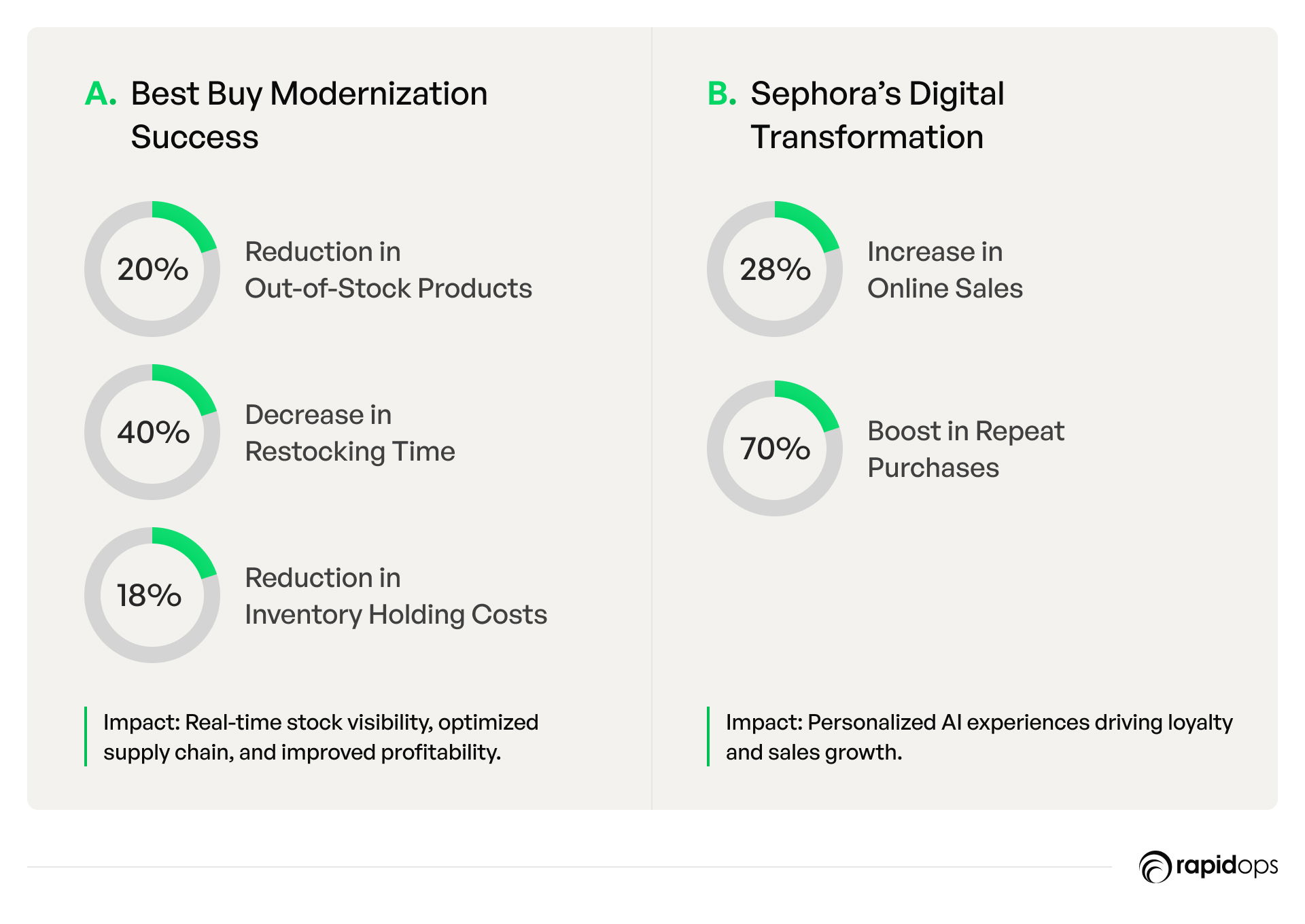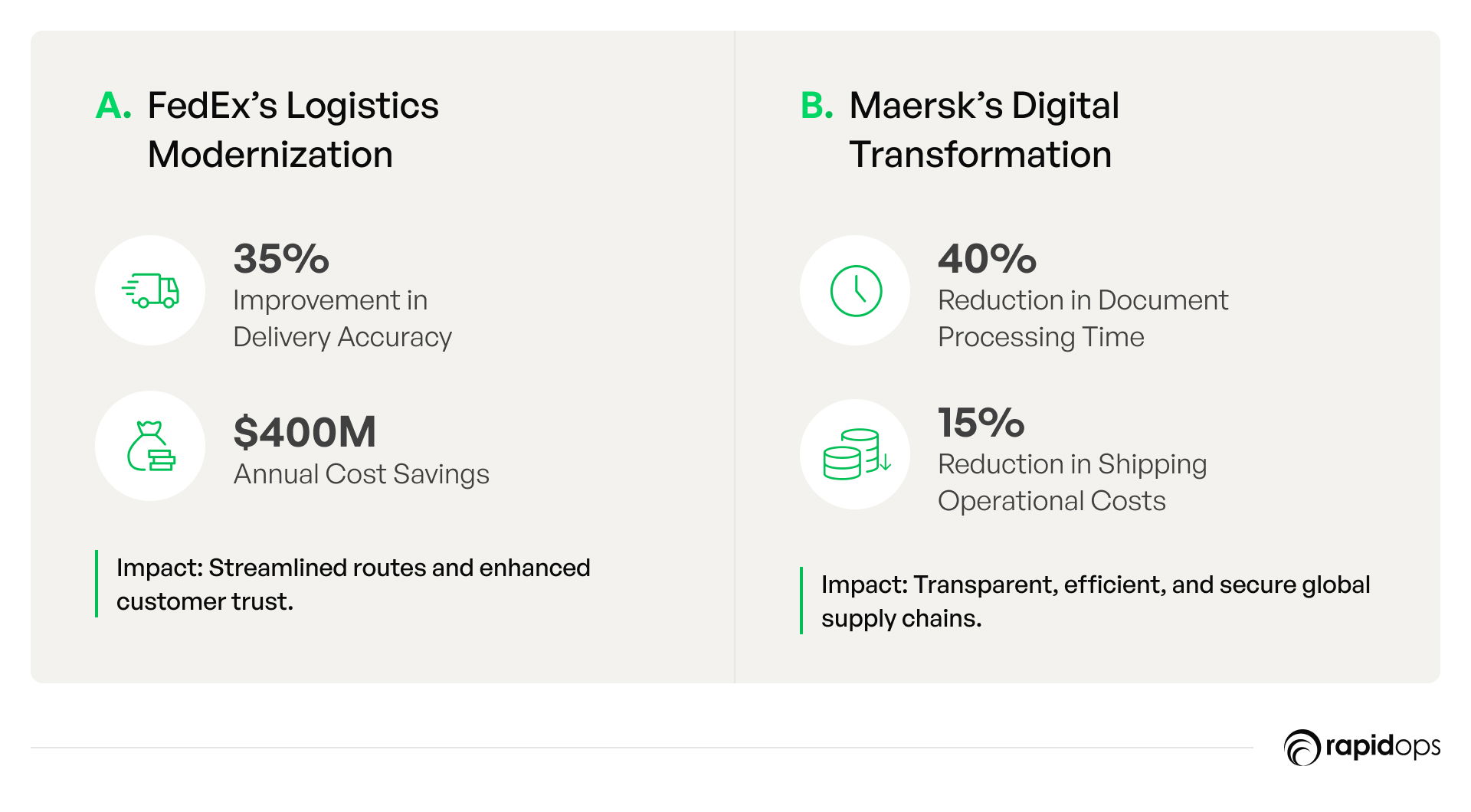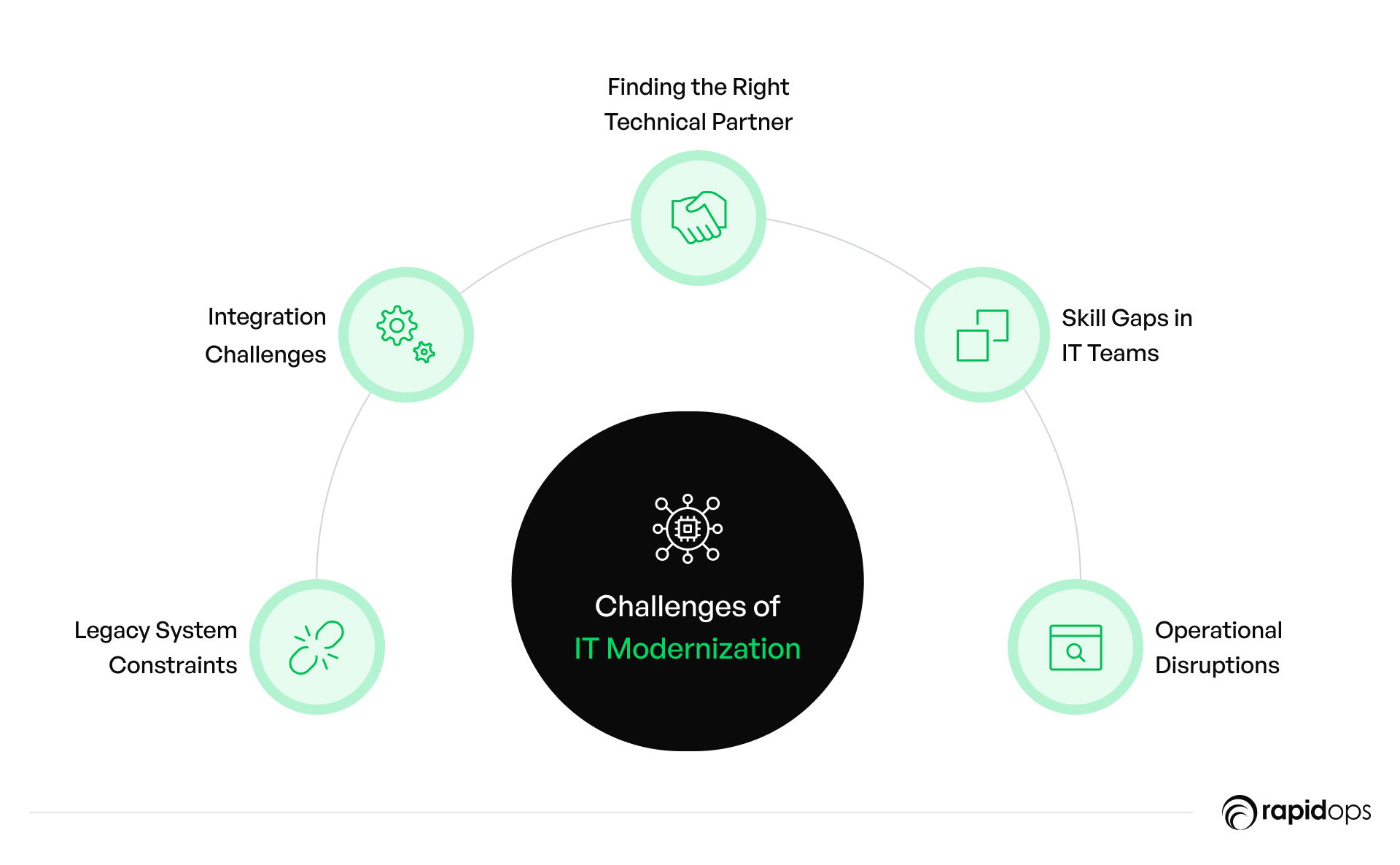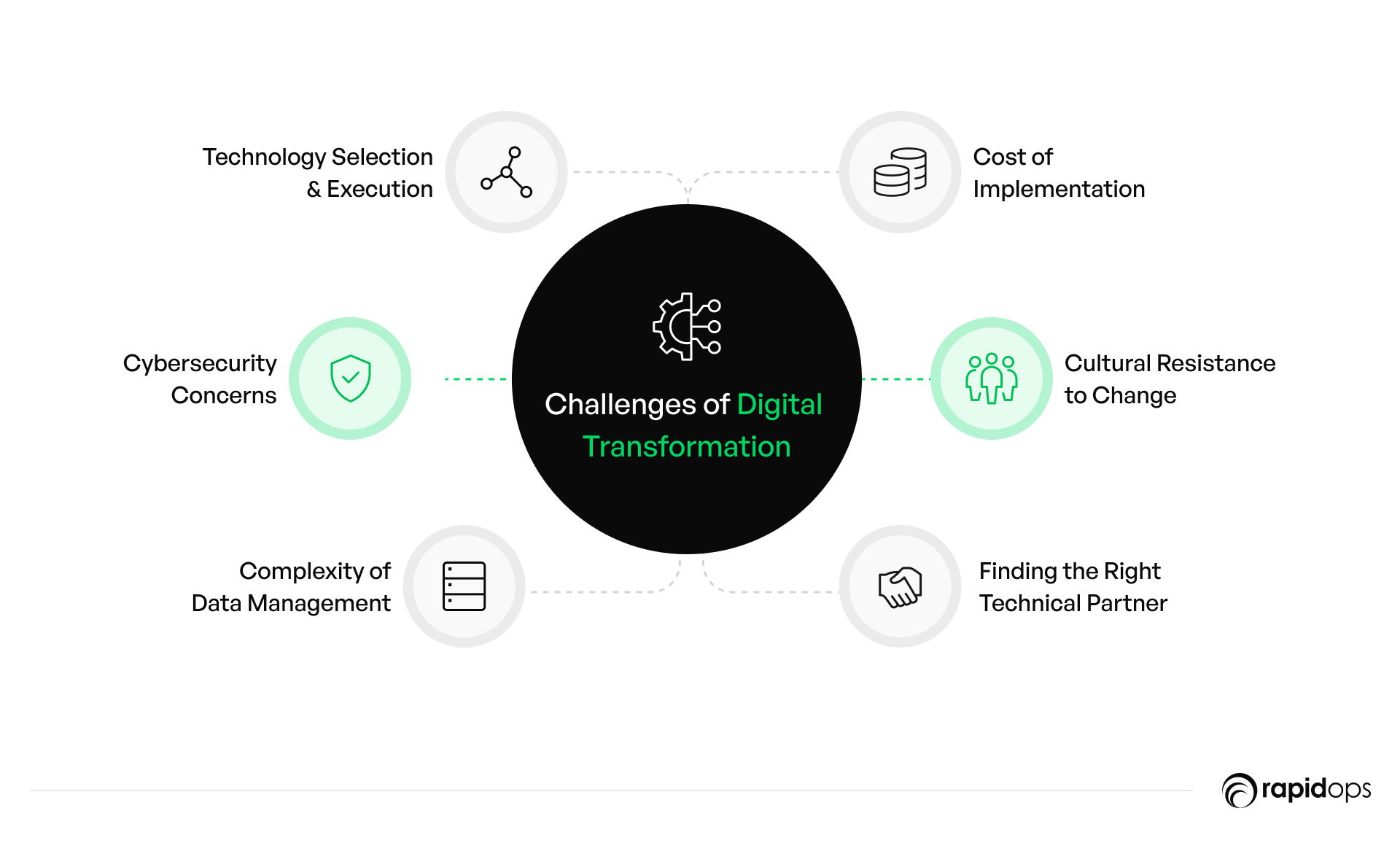- Transformation
- 13 min read
- January 2025
IT Modernization vs Digital Transformation: Major Differences
Key Takeaways
Are you upgrading systems or reimagining your business strategy?
Imagine this: A growing manufacturing company invests heavily in upgrading its legacy systems, streamlining operations and improving efficiency. Yet, despite these investments, challenges persist supply chain bottlenecks remain, customers demand real-time updates, and competitors continue to innovate and pull ahead with digital-first solutions. Leadership wonders, “Why aren’t our technology investments delivering the expected results?”
This issue is common in industries like retail, healthcare, and logistics confusing IT modernization with digital transformation. IT modernization upgrades legacy systems using technologies like AI, IoT, and blockchain to improve efficiency. Digital transformation, on the other hand, redefines business operations, leveraging these same technologies to drive innovation and enhance customer experiences.
What’s at stake? Companies that stop at modernization risk stagnation. Studies show that 60% of businesses struggle to align technology with strategic goals, while those embracing digital transformation are 23% more profitable and better equipped to adapt to disruptions. With 75% of customers expecting seamless digital experiences, transformation is essential, not optional.
This article will explore the differences between IT modernization and digital transformation, highlight industry-specific applications, and provide actionable strategies to help you align technology with long-term success.
Defining IT modernization and digital transformation
What is IT modernization?
IT modernization is the strategic process of upgrading an organization's technology infrastructure, applications, and legacy systems to enhance efficiency, security, and scalability. Rather than replacing everything at once, enterprise IT modernization focuses on systematically improving existing systems to align with evolving business needs. This includes adopting cloud technologies, automating workflows, and strengthening cybersecurity measures to ensure a resilient IT environment.
Effective IT modernization enables businesses to reduce operational costs, enhance system performance, and support innovation without disrupting core operations. It also ensures that IT infrastructure modernization can seamlessly integrate with emerging technologies, allowing organizations to stay competitive in a rapidly evolving digital landscape.
What is digital transformation?
Digital transformation takes modernization a step further by fundamentally reshaping how businesses operate, deliver value, and interact with customers. While IT modernization services focus on optimizing existing technology, digital transformation reimagines business models by leveraging AI, automation, IoT, and cloud computing to drive growth and innovation.
This transformation extends beyond IT, impacting organizational culture, decision-making, and customer experiences. Enterprises that embrace digital transformation don’t just improve processes, they unlock new revenue streams, create seamless digital experiences, and position themselves as industry leaders in the digital-first economy.
By strategically combining IT modernization with digital transformation initiatives, organizations can build a future-ready enterprise that thrives on agility, efficiency, and innovation.
Key differences between IT modernization and digital transformation
In today's fast-evolving digital landscape, businesses must choose between IT modernization and digital transformation to stay competitive. While both strategies involve leveraging technology for growth, they serve different purposes. IT modernization focuses on upgrading existing systems for efficiency, whereas digital transformation redefines business models and customer experiences.
I. Objective
IT modernization: Enhancing existing systems for efficiency
The primary goal of IT modernization is to optimize legacy IT systems and ensure that an organization’s technology infrastructure remains reliable, secure, and cost-effective. This includes upgrading outdated software, moving to cloud-based solutions, and implementing automation to improve operational performance.
A well-planned IT modernization strategy ensures that businesses can meet current demands without disrupting core operations. By focusing on legacy IT modernization, companies can eliminate inefficiencies while preparing their systems for future technological advancements.
Digital transformation: A holistic business overhaul
Digital transformation is a strategic shift that fundamentally redefines how a business operates and delivers value. Unlike IT modernization, which focuses on internal efficiencies, digital transformation involves new business models, customer engagement strategies, and revenue streams. Companies undergoing digital transformation embrace technologies like AI, IoT, and blockchain to create innovative, data-driven solutions.
II. Scope
IT modernization: Upgrading infrastructure without disrupting core operations
Enterprise IT modernization primarily involves migrating legacy systems, enhancing ERP solutions, and automating routine processes. The focus remains on IT infrastructure modernization, ensuring that backend systems operate faster, more securely, and with improved reliability. However, it does not fundamentally change how a company conducts business.
Digital transformation: A complete business and technology revamp
Digital transformation impacts every aspect of an organization, from internal processes and leadership structures to customer interactions and market positioning. It goes beyond IT digital modernization by fostering a culture of continuous innovation, adaptability, and digital-first operations.
III. Technology involved
IT modernization: Leveraging existing technologies for stability
IT Modernization leverages established technologies such as cloud computing, AI for automation, and ERP systems to improve infrastructure and enhance system reliability. These updates ensure systems perform better but are built on existing frameworks.
Digital transformation: Implementing disruptive technologies
Digital transformation relies on advanced, disruptive technologies such as machine learning, IoT, blockchain, and predictive analytics. These technologies do more than optimize operations; they redefine business models, drive real-time decision-making, and create new customer experiences.
IV. ROI and business impact
IT modernization: Immediate efficiency gains
A well-executed IT modernization strategy delivers rapid cost savings, enhanced security, and improved system performance. Businesses experience lower maintenance costs and fewer system downtimes while ensuring regulatory compliance and cybersecurity resilience.
Digital transformation: Long-term growth and market expansion
Digital transformation unlocks long-term ROI by creating new revenue streams, building stronger customer relationships, and boosting market positioning. By leveraging data analytics and automation, businesses optimize operations, enhance agility, and scale efficiently, making it a key investment for sustainable growth.
V. Workforce impact
IT modernization: Minimal disruption with targeted upskilling
Modernizing IT requires retraining employees to operate upgraded IT infrastructure and leverage automation tools. However, since the core processes remain the same, the cultural shift is gradual and manageable.
Digital transformation: A cultural and operational shift
Digital transformation requires organizations to adopt a digital-first mindset, fostering cross-functional collaboration and significant workforce reskilling. This often involves hiring new talent or leveraging external IT modernization services to drive innovation.
VI. Customer-centric focus
IT Modernization: Indirect improvements in customer experience
By streamlining backend operations, automating workflows, and improving system reliability, legacy IT modernization indirectly benefits customers. Faster response times, better data security, and improved service delivery contribute to a more seamless customer experience.
Digital transformation: Reinventing customer engagement
Digital transformation places customers at the center of business strategy. Companies leverage AI-driven personalization, predictive analytics, and omnichannel engagement to anticipate customer needs and deliver tailored, frictionless experiences.
VII. Flexibility and scalability
IT modernization: Enhancing current systems with some limitations
While IT modernization enhances existing infrastructure, it often operates within the constraints of legacy systems. IT infrastructure modernization improves efficiency, but its scalability depends on existing frameworks.
Digital transformation: Building for agility and future growth
Digital transformation embraces cloud-native architecture, automation, and real-time analytics, enabling businesses to adapt quickly to market changes and scale effortlessly. It fosters an agile, innovation-driven ecosystem that ensures long-term sustainability.
Choosing the right path: IT modernization vs. Digital transformation
Deciding between IT modernization and digital transformation depends on your organization's goals, resources, and market positioning. If your priority is optimizing existing IT infrastructure, a legacy IT modernization approach can enhance performance without major disruptions. However, if your focus is long-term innovation and business reinvention, digital transformation provides the strategic agility needed to stay ahead of the competition.
Both approaches offer distinct advantages, and in many cases, a hybrid strategy combining IT modernization and digital transformation can deliver the best results. The key is to align your IT modernization strategy with your business vision, ensuring that your organization is future-ready, resilient, and poised for sustained success.
Strategic insights for decision-makers
When to choose IT modernization
IT modernization is the strategic process of upgrading or replacing outdated technology to enhance efficiency, security, and scalability. This approach is ideal when a business seeks to optimize its existing IT infrastructure without completely overhauling its operational model.
Key considerations for IT modernization strategy
- Identifying pain points: What inefficiencies, costs, or security risks are caused by legacy systems?
- Scalability needs: Can current IT infrastructure support future business growth?
- Security risks: Are outdated systems exposing the organization to cybersecurity threats?
- Incremental upgrades: Can enterprise IT modernization be implemented without disrupting business operations?
- Cost analysis: What is the financial impact of modernizing IT systems versus maintaining legacy systems?
- Customer & operational impact: How can IT modernization services enhance customer experience and business agility?
Enterprise IT modernization in action
Modernizing IT systems isn’t just about staying current, it’s about ensuring long-term resilience. Organizations leveraging cloud IT modernization can reduce operational costs, improve system performance, and enhance data security. With a phased approach, businesses can upgrade critical components while maintaining operational continuity.
When to choose digital transformation
Unlike IT modernization, which optimizes existing systems, digital transformation reimagines how an organization operates. This approach involves leveraging emerging technologies to enhance business models, customer experiences, and overall agility.
Key considerations for digital transformation
- Strategic alignment: How does digital transformation integrate with long-term business goals?
- Customer-centric innovation: Are current digital capabilities meeting evolving customer expectations?
- Business model evolution: Are legacy processes limiting innovation and growth potential?
- Emerging technologies: Can AI, IoT, or automation create a competitive advantage?
- Cultural readiness: Does the organization have leadership commitment and an adaptive workforce?
- Risk management: What are the challenges of digital transformation, and how can they be mitigated?
- Workforce impact: How will digital adoption reshape job roles and skill requirements?
- Success metrics: What KPIs will measure the effectiveness of digital transformation initiatives? Future proofing with digital transformation
A forward-thinking digital strategy ensures that businesses remain agile, competitive, and customer focused. Companies adopting digital transformation gain a competitive edge by streamlining operations, enhancing user experiences, and driving innovation.
The decision between IT legacy modernization and full-scale digital transformation hinges on business objectives, technological constraints, and long-term goals. By answering these critical questions, leaders can determine whether to stabilize and optimize existing IT systems or embrace transformative change for sustained growth and success.
How to align choices with business goals
Decision matrix based on organizational priorities
Use this decision matrix to align your strategy with organizational goals.
| Factor | IT Modernization | Digital Transformation |
| Stability vs. Innovation | Focuses on stability, operational efficiency, and minimizing disruptions. | Prioritizes disruption, innovation, and reimagining business processes. |
| IT Investment Strategy | Lower initial costs; focuses on technology modernization while retaining core systems. | Requires a higher upfront cost, but with long-term ROI |
| Market Adaptability | Provides incremental improvements but may have limited scalability. | Highly scalable IT solutions that enable future adaptability and business model evolution. |
| Customer Engagement Needs | Enhances backend systems with limited customer-facing changes. | Enables personalized, data-driven experiences for deeper customer engagement. |
| Current Technology Infrastructure | Ideal for companies extending the life of existing systems through legacy system modernization. | Best for businesses adopting emerging technologies and cloud-native platforms. |
Technology gap analysis
To understand where your organization stands, conduct a technology gap analysis. This will help identify where your existing systems fall short and where they align with future business needs.
Key questions to ask
Does your current infrastructure allow for flexibility and growth, or are you dealing with siloed operations and inefficiencies?
Are customer-facing systems unable to meet modern demands, such as personalized interactions or real-time responses?
Is your current technology ready for future innovation, or do you need a complete overhaul to meet evolving demands?
By assessing your current state and aligning your goals with these insights, you can make a decision that sets your organization on a path to success.
Choosing between IT modernization and digital transformation shapes your organization's future. Modernization enhances existing systems for stability and efficiency, while Transformation drives innovation and market leadership. Align your decision with business goals to secure both immediate impact and long-term success in a digital-first world.
Industry-specific applications and examples
Technology adoption varies across industries, shaping whether businesses modernize IT for efficiency or transform digitally for innovation. Choosing the right approach ensures industry-specific success, aligning IT investments with business needs, customer demands, and long-term competitiveness.
I. Retail: Enhancing customer experience and operational efficiency

IT modernization: Upgrading systems for scalability
Retailers must modernize their IT infrastructure to improve efficiency, reduce costs, and ensure seamless operations. IT modernization solutions, such as cloud-based inventory management and AI-driven demand forecasting, enable businesses to optimize supply chain management and enhance customer experiences.
Case study
Best Buy implemented IT infrastructure modernization by upgrading its inventory system to a cloud-based platform, ensuring real-time tracking and efficient stock replenishment.
Outcome
- 20% reduction in out-of-stock products
- 40% decrease in restocking time
- 18% lower inventory holding costs
Impact
This demonstrates how business-driven IT modernization enhances efficiency without overhauling the core business model.
Digital transformation: Personalizing customer interactions
Unlike IT modernization, digital transformation integrates technologies like AI, omnichannel commerce, and predictive analytics to redefine customer engagement. Retailers leverage data-driven insights to offer hyper-personalized shopping experiences and optimize omnichannel strategies.
Case study
Sephora integrated AI-powered product recommendations and virtual try-ons, revolutionizing both online and in-store customer experiences.
Outcome
- 28% increase in online sales
- 70% growth in repeat purchases from app users
Impact
Sephora’s approach highlights how digital transformation through IT modernization can drive customer loyalty and new revenue streams.
II. Manufacturing: Streamlining operations and proactive maintenance

IT modernization: Improving operational efficiency
Manufacturers need to modernize legacy systems to streamline operations and improve resource management. IT legacy modernization enhances ERP capabilities, ensuring real-time data access for better decision-making.
Case study
Boeing centralized supply chain management by upgrading its ERP system, enabling real-time data sharing.
Outcome
- 25% reduction in procurement delays
- $100 million saved annually through operational efficiency
Impact
By implementing a strong IT modernization strategy, Boeing improved cost control and resource management, demonstrating the immediate benefits of upgrading legacy systems.
Digital transformation: Enabling smart manufacturing
Digital transformation in manufacturing integrates AI, IoT, and predictive maintenance to enhance efficiency and minimize downtime.
Case study
Toyota implemented AI-driven demand forecasting, optimizing global inventory levels in real time.
Outcome
- 10% improvement in inventory management
- 5% reduction in operational costs
Impact
Toyota’s shift illustrates how digital transformation through IT modernization enables manufacturers to proactively manage production, reducing waste and improving agility.
III. Distribution: Optimizing logistics and enhancing transparency

IT Modernization: Enhancing logistics performance
The distribution industry relies on real-time tracking and automation to optimize logistics. IT modernization services, such as cloud-based logistics platforms, ensure businesses can efficiently manage shipments and reduce operational inefficiencies.
Case study
FedEx implemented an AI-powered logistics platform to optimize delivery routes and reduce delays.
Outcome
- 35% improvement in delivery accuracy
- $400 million in annual savings
Impact
By modernizing its logistics infrastructure, FedEx improved efficiency and service reliability, proving the impact of business-driven IT modernization in optimizing operations.
Digital transformation: Reinventing supply chains
Leading distribution companies are leveraging blockchain and AI to increase supply chain transparency and efficiency.
Case Study
Maersk partnered with IBM to launch TradeLens, a blockchain-based supply chain platform for real-time tracking and secure data sharing.
Outcome
- 40% reduction in document processing time
- 15% reduction in shipping costs
Impact
Maersk’s initiative showcases how digital transformation through IT modernization delivers significant cost savings and transparency across the supply chain.
The time to act is now. Both IT modernization and digital transformation are vital for staying competitive, but the path you choose depends on your organization's unique needs and objectives.
Key challenges in IT modernization and digital transformation
Identifying pitfalls in IT modernization

Legacy system constraints
Legacy systems create bottlenecks for IT modernization, limiting compatibility with AI, cloud, and IoT solutions. Maintaining outdated infrastructure escalates costs, introduces security vulnerabilities, and reduces agility, hindering an organization’s ability to scale or innovate.
Integration complexities
Merging modern IT solutions with legacy infrastructure often demands custom integrations that increase costs and introduce operational silos. These IT adoption challenges create fragmented workflows, leading to downtime risks and inefficiencies that undermine transformation efforts.
IT modernization risks in vendor selection
Selecting a technical partner without expertise in scalable IT solutions can result in ineffective modernization, misaligned roadmaps, and wasted investments. Organizations must evaluate vendor capabilities to ensure business-driven IT modernization aligns with long-term strategic goals.
Skill gaps in IT teams
Adopting modern IT infrastructure requires cloud, cybersecurity, and data migration expertise, areas where internal teams often lack proficiency. This results in reliance on third-party consultants, delaying implementation and increasing costs. Upskilling initiatives are essential to sustain technology modernization efforts.
Operational disruptions & IT modernization obstacles
Unstructured IT modernization leads to downtime, data migration failures, and disruptions, particularly in industries where real-time availability is critical. Without phased implementation and risk mitigation strategies, organizations expose themselves to legacy system modernization risks that impact business continuity.
Identifying pitfalls in digital transformation

High implementation costs
Digital transformation strategies demand significant investment in new technologies, system integrations, and workforce training. Without a clear ROI-driven roadmap, businesses risk budget overruns that can strain financial stability.
Cultural resistance to change
Beyond IT adoption challenges, transformation requires an organizational mindset shift. Resistance from employees and leadership often slows progress, making change management strategies crucial for a smooth transition.
Complexity in data management
With data silos and increasing volumes of structured and unstructured data, businesses struggle to integrate and analyze information effectively. Poor data governance strategies limit the value of AI-driven insights and predictive analytics, undermining transformation success.
Cybersecurity risks in digital-first operations
As companies embrace cloud IT modernization, cybersecurity threats escalate. Weak compliance frameworks expose sensitive data to breaches, making proactive security investments essential to safeguard customer trust and operational resilience.
Technology selection challenges
Choosing the wrong technology stack leads to inefficiencies, legacy system modernization risks, and missed growth opportunities. A misaligned IT strategy results in excessive complexity, redundant tools, and an inability to scale IT solutions effectively.
Organizations must proactively address IT modernization risks and digital transformation obstacles. Tackling integration challenges, skill gaps, and security vulnerabilities is critical to mitigating IT adoption challenges and legacy system modernization risks, ensuring a seamless transition in a rapidly evolving digital landscape.
From vision to action: What’s your next move?
The decisions you make today will shape your business’s resilience and competitiveness for years to come. Whether you're refining your existing systems through IT modernization or embarking on a full transformation, the key is to take decisive action that aligns with your long-term vision.
But finding the right path forward can be challenging. Do you optimize your current operations or reinvent your approach? How do you strike the right balance between immediate efficiency and future innovation? These are common questions, and many leaders face similar uncertainties.
At Rapidops, we specialize in cutting through complexity, helping businesses like yours assess where they stand and craft a roadmap that delivers immediate value while setting the stage for long-term growth and sustainability.
Looking for clarity on your next move? Let’s have a conversation. Schedule a free consultation, and together, we'll tailor a strategy that drives both short-term success and lasting impact for your business.
Frequently Asked Questions
What are the risks of focusing only on modernization?
Can modernization and transformation work together?
What leadership skills drive successful modernization or transformation?
How do modernization and transformation impact budgets and ROI?
What are the hidden costs of modernization and transformation?
What’s Inside
- Defining IT modernization and digital transformation
- Key differences between IT modernization and digital transformation
- Strategic insights for decision-makers
- Industry-specific applications and examples
- Key challenges in IT modernization and digital transformation
- From vision to action: What’s your next move?




